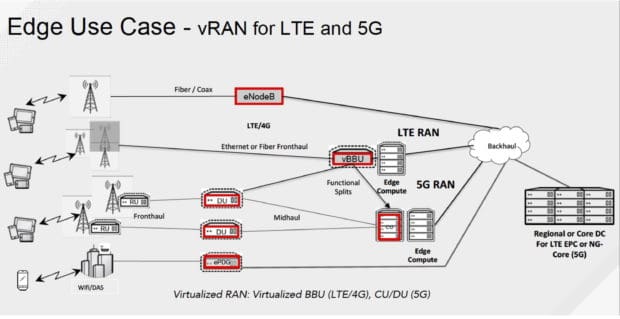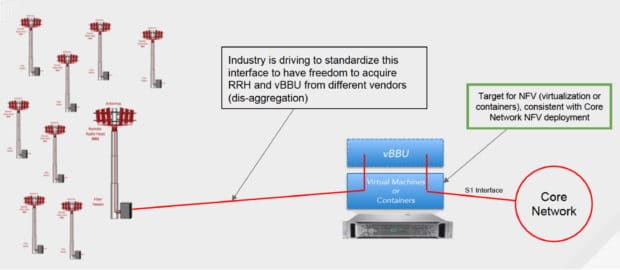Virtual radio access networks (
Radio access networks comprise antennas, base stations, and controllers. They are one of the most expensive elements in a mobile network as well as carrying the highest volumes and have so far required special software and hardware. Due to the technological complexity associated with wireless signal transmission, RAN performance is critical as it directly and noticeably impacts customer experience. A virtual RAN (vRAN) solution offers an alternative to part of proprietary, hardware-based radio access networks.

The vRAN originates from Network Functions Virtualization (NFV), which transfers a typical hardware-based network architecture to a software-based environment. Similarly, a vRAN converts vendor-specific base stations into flexible, cost-effective systems. Mobile network operators (MNOs) activate functions of the baseband unit (BBU) by using virtual machines (VMs) or alternatively containers on standard servers in an edge datacentre. In this software-dominated architecture, some functions of conventional base stations are relocated to servers in the edge datacentre. This is disaggregation of the base station and is called function split, or functional split.
The benefit of virtualization becomes particularly apparent when looking at software updates and upgrades. In a hardware-based, non-virtualized environment, MNOs must equip each individual base station with new software. In a virtualized architecture, many functions are located on VMs or containers that run on servers in the edge datacentre. Software distribution, which runs centrally and preferably automatically, greatly simplifies the amount of administrative effort required and also makes it less prone to errors, as it eliminates manual intervention.
vRAN, however, is a complex and challenging use case, as the technical requirements placed on wireless signaling are very high, for example around real-time processing and latency. The performance of the RAN is crucial as it directly and noticeably impacts on customer experience. After a series of proof of concepts (PoCs), as well as laboratory and field tests, vRAN technology is now ready to be used in production. Operators of 4G LTE networks have already begun to implement the technology in recent months.

We can expect the first commercial implementations of vRANs to go into operation in 2019 along with the functional split of 4G LTE base stations. In doing so, network operators can migrate the functions of the BBU in edge datacentres and use virtualized BBUs (vBBUs). Thanks to the central processing power of an edge datacentre and function pooling, mobile network operators will be able to benefit from capital expenditure (CAPEX) and operating expense (OPEX) savings, operational increases in efficiency, as well as enhanced performance management techniques. The advantages of increased processing power of centrally arranged BBUs can also enable more efficient interference control technologies such as eICIC (Enhanced Inter-Cell Interference Coordination).
This type of vRAN environment offers network operators a broad range of network components. It enables them to configure their environment with the aim of pooling resources at several mobile sites and scaling capacities in accordance with specific requirements. This way, they can also reduce support and maintenance expenditure.
5G and virtual radio access networks
Virtual radio access networks are among the most important disaggregation projects in the telecommunications industry as they open up new ways to design and implement increased numbers of vendor-independent solutions. The prerequisite for these – particularly with regard to 5G – is the standardization and definition of interfaces to allow network operators to freely combine components from suppliers of their choice. It is expected that the standardization process for 5G will be largely completed by the end of 2019.
As the standardization and coordination processes are in full swing at present, there are currently various methods for dividing up the functions of the base stations between the antenna location and edge datacentres. This applies both to the split model of the 4G LTE base station (eNodeB) and to the 5G New Radio (gNodeB, 5G base stations) between distributed units (DUs) and centralized units (CUs). Although a simple split into RANs and edge datacentres is envisaged in 4G LTE networks, there will be a three-part hierarchy for 5G: base stations, DUs, and CUs. One reason for this is that there will be significantly more base stations in 5G networks than there are in 4G LTE networks. The CUs are designed as a distributed cloud solution with low space requirements. In contrast, the DUs are to perform tasks such as real-time processing, supporting the Precision Time Protocol (PTP), and hardware acceleration with field-programmable gate arrays (FPGAs) and smart network interface cards (Smart NICs).
5G as the basic architecture
5G will form the basic architecture for enabling a wide range of applications and services, including faster mobile networks, very low latency, edge use cases, machine-to-machine communication and the Internet of Things (IoT), telemedicine, personalized robots, as well as augmented reality (AR) and virtual reality (VR) services. It will take some time before all these services are widely available. Organizations will then be able to use 5G in combination with other technologies such as drones, face recognition, and VR application scenarios in telemedicine.
As with edge datacentres, DUs and CUs in 5G networks should perform important tasks for the purpose of enabling innovative new services and applications. Network slicing enables multiple workloads; in this case vRANs are then just one workload among many others. Some service providers are containerizing their environment for greater agility, using an enterprise Kubernetes platform to help their developers to build cloud-native applications using a microservices approach, and abstract applications from the underlying hardware so they can be run and scaled across different environments seamlessly. Many mobile service providers already operate commercial 5G test environments (although often restricted to a local level), and in the coming months numerous new projects are expected to emerge. Open source technologies play a decisive role in many of these projects.





